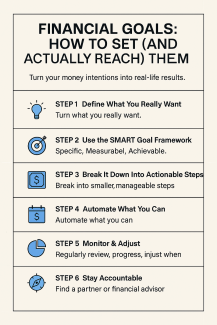
🎯 Financial Goals: How to Set (and Actually Reach) Them
Turn your money intentions into real-life results.
Everyone talks about the importance of having financial goals—but setting them is only half the battle. Reaching those goals? That takes intention, structure, and strategy. Whether you're saving for a home, paying off debt, or building wealth for retirement, knowing how to set and follow through with financial goals can make all the difference.
In this guide, we’ll walk you through the steps to set clear, achievable financial goals—and stick with them.
💡 Why Financial Goals Matter
Without a target, your money decisions can feel aimless. Financial goals give you direction, motivation, and a framework for making smart choices. They help you prioritize where your money goes and stay focused when distractions or setbacks arise.
✅ Step 1: Define What You Really Want
Start by identifying your why. What are you working toward? Think beyond the numbers—focus on the outcomes you care about:
- Buying a first home
- Becoming debt-free
- Starting a business
- Traveling more
- Retiring early
- Building generational wealth
These desires will shape your financial plan.
🎯 Step 2: Use the SMART Goal Framework
Set yourself up for success by making your goals SMART:
- Specific – Clearly define what you want
- Measurable – Track progress with real numbers
- Achievable – Keep goals realistic and doable
- Relevant – Align goals with your values and priorities
- Time-bound – Set a deadline or target timeframe
Example:
❌ “Save money for a house.”
✅ “Save $20,000 for a down payment within 18 months.”
💸 Step 3: Break It Down Into Actionable Steps
Big goals feel overwhelming without a plan. Break them into smaller, manageable steps:
Goal: Pay off $10,000 in credit card debt
Steps:
- Stop adding new debt
- Allocate $500/month to repayment
- Use the avalanche method (highest interest first)
- Track progress monthly
Smaller wins help build momentum.
📅 Step 4: Automate What You Can
The less effort it takes, the more likely you'll stick with it. Automate savings, debt payments, or investing whenever possible.
- Set up automatic transfers to a savings account
- Use direct deposit to fund multiple goals
- Schedule monthly contributions to retirement or brokerage accounts
Automation turns discipline into habit.
🧠 Step 5: Monitor & Adjust
Life happens—and your goals might need to evolve. Schedule regular check-ins (monthly or quarterly) to review your progress. Are you ahead? Behind? Do your priorities still match your goals?
If needed, adjust timelines, contribution amounts, or even the goals themselves. Flexibility is part of the process.
🧭 Step 6: Stay Accountable
Accountability increases your odds of success. Share your goals with a partner, friend, or financial advisor who can help keep you on track and offer guidance when needed.
Bonus: Use a financial app or journal to track your progress and stay motivated.
Final Thoughts
Financial goals aren’t just numbers on a spreadsheet—they’re stepping stones to the life you want. With a clear plan, a smart structure, and a few consistent habits, you can move from dreaming to doing.
👉 Need help mapping out your financial goals? A certified financial planner can help you create a custom strategy and support you at every step. Because with the right plan, your financial future isn’t just possible—it’s within reach.

